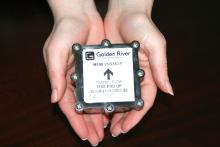Deployment of solar-powered LED road studs has provided significant cost benefits whilst reducing KSIs on notorious routes in South Africa. Can these results be replicated in other regions of the world and on less notorious stretches of road? According to Kevin Adams, Astucia's CEO, they can.

Kevin Adams, CEO of Astucia
RSSDeployment of solar-powered LED road studs has provided significant cost benefits whilst reducing KSIs on notorious routes in South Africa. Can these results be replicated in other regions of the world and on less notorious stretches of road? According to Kevin Adams, 1875 Astucia's CEO, they can.
"Astucia SolarLite studs have been installed in many regions of the world, in countries as widespread as Venezuala, Peru, Poland and Australia, and they are helping to reduce global KSI rates," Adams points out. "Their use in the UK has also shown dramatic reductions in accident rates on roads right across the country from Norfolk to Barry in Wales. With over eight fatal accidents in the UK every day and around half the fatalities occurring at night, these studs provide an innovative aid in the bid to make our roads safer."
Adams cites the deployment in Norfolk, where the A143 links the Norfolk Broads towns of Beccles and Great Yarmouth, as a case in point. The road crosses the Haddiscoe Marshes on a sinuous, 2km embankment known as the Haddiscoe Dam.
To reduce the number of accidents at this location Norfolk County Council took a number of initiatives which involved resurfacing the road to improve skid resistance and also installing Astucia solar-powered road studs. The initial installation was comprised of over 200 studs providing delineation of the centreline. The positioning of the studs was carefully designed to provide drivers with advanced indication of the nature of the road layout ahead.
Immediate improvement
Nevil Calder, Principal Engineer - Safety and Traffic Management for Norfolk County Council is delighted with the results of the safety scheme. "In the first two years since the scheme was introduced we noticed an immediate improvement in road safety; there were only five recorded accidents, all of which were slight, with none occurring in the dark and only one during wet conditions. The overall accident frequency has reduced from 7.3 per year to 2.3 whilst the severity ratio has reduced from 36 per cent to zero."
With each fatality in the UK costing around $3.05 million, this would have seen an initial cost of over $6.6 million for 22 KSIs. After installation of SolarLite studs this would have been dramatically reduced. As Adams points out, with an installation cost of less than $10,000 for the studs, this provides a compelling financial case, even before considering the terrible consequences of a serious or fatal accident cause.
Adams concedes that, at first glance, some people may consider the initial installation costs of Astucia Solarlite studs to be prohibitive at around $48 (installed). However, as he points out, lasting over the full lifetime of the road surface they can provide greater value than the traditional Halifax-style studs which require replacement on a fairly regular basis.
"This means that the whole life cost of the SolarLite stud, which has an average life of eight-10 years, is actually cheaper than the traditional road stud, with a significant reduction of accidents where they are deployed,"
he adds. RSS
"Astucia SolarLite studs have been installed in many regions of the world, in countries as widespread as Venezuala, Peru, Poland and Australia, and they are helping to reduce global KSI rates," Adams points out. "Their use in the UK has also shown dramatic reductions in accident rates on roads right across the country from Norfolk to Barry in Wales. With over eight fatal accidents in the UK every day and around half the fatalities occurring at night, these studs provide an innovative aid in the bid to make our roads safer."
Adams cites the deployment in Norfolk, where the A143 links the Norfolk Broads towns of Beccles and Great Yarmouth, as a case in point. The road crosses the Haddiscoe Marshes on a sinuous, 2km embankment known as the Haddiscoe Dam.
Dominant accident type
Adams: "Over a three-year period there were 22 recorded accidents, two of which involved loss of life, along with six causing serious injury and 14 others considered as minor. The dominant accident types, comprising 95 per cent of all accidents recorded, were as a result of loss of control. With its route across the low-lying marshes a high number of these accidents appeared to be during damp and misty conditions that are often prevalent, with 40 per cent occurring in the dark and 65 per cent when the road was wet."To reduce the number of accidents at this location Norfolk County Council took a number of initiatives which involved resurfacing the road to improve skid resistance and also installing Astucia solar-powered road studs. The initial installation was comprised of over 200 studs providing delineation of the centreline. The positioning of the studs was carefully designed to provide drivers with advanced indication of the nature of the road layout ahead.
Immediate improvement
Nevil Calder, Principal Engineer - Safety and Traffic Management for Norfolk County Council is delighted with the results of the safety scheme. "In the first two years since the scheme was introduced we noticed an immediate improvement in road safety; there were only five recorded accidents, all of which were slight, with none occurring in the dark and only one during wet conditions. The overall accident frequency has reduced from 7.3 per year to 2.3 whilst the severity ratio has reduced from 36 per cent to zero."With each fatality in the UK costing around $3.05 million, this would have seen an initial cost of over $6.6 million for 22 KSIs. After installation of SolarLite studs this would have been dramatically reduced. As Adams points out, with an installation cost of less than $10,000 for the studs, this provides a compelling financial case, even before considering the terrible consequences of a serious or fatal accident cause.
Adams concedes that, at first glance, some people may consider the initial installation costs of Astucia Solarlite studs to be prohibitive at around $48 (installed). However, as he points out, lasting over the full lifetime of the road surface they can provide greater value than the traditional Halifax-style studs which require replacement on a fairly regular basis.
"This means that the whole life cost of the SolarLite stud, which has an average life of eight-10 years, is actually cheaper than the traditional road stud, with a significant reduction of accidents where they are deployed,"
he adds. RSS






